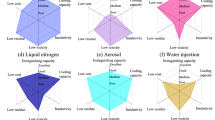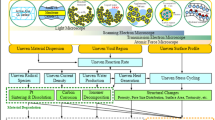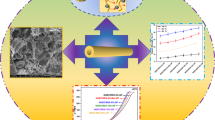Abstract
To increase fuel utilization and decrease the total cost of a nuclear reactor, it is ideal to prolong the core lifetime of a nuclear reactor as high as possible. Burnable poisons (with large neutron absorption cross sections) play a great role in this process. Burnable poisons’ material, amount, concentration, and location inside the fuel assembly, as well as inside the reactor core, are the variable parameters that the designer of a pressurized water reactor can employ to attain a desirable core lifetime. In this paper, a new pattern and combination of two well-known poisons are proposed and applied for a standard AP1000 fuel assembly as our case study. The new suggested combinatorial of erbium and gadolinium bearing rods resulted in an excellent performance in less reactivity swing and negative Moderator Temperature Coefficient. The less reactivity swing can, in turn, provide the stability of the infinity multiplication factor. The stability and flattening of the reactivity will lower the cost of conserving the criticality state of the fuel.












Similar content being viewed by others

Data Availability Statement
This manuscript has associated data in a data repository. [Authors’ comment: The data that support the findings of this study are available on request from the corresponding author.]
References
F. Khoshahval, S.S. Foroutan, A. Zolfaghari, H. Minuchehr, Evaluation of burnable absorber rods effect on neutronic performance in fuel assembly of WWER-1000 reactor. Ann. Nucl. Energy 87, 648–658 (2016)
A.A. Galahom, Searching for the optimum number of integral burnable absorber rods used in PWR assembly. Int. J. Nucl. Energy Sci. Technol. 13(2), 180–194 (2019)
E.H. Uguru, S.F.A. Sani, M.U. Khandaker, M.H. Rabir, J.A. Karim, A comparative study on the impact of Gd2O3 burnable neutron absorber in UO2 and (U, Th)O2 fuels. Nucl. Eng. Technol. 52(6), 1099–1109 (2020)
J. Choe, H.C. Shin, D. Lee, New burnable absorber for long-cycle low boron operation of PWRs. Ann. Nucl. Energy 88, 272–279 (2016)
J.P.A. Renier, M. Grossbeck, Development of Improved Burnable Poisons for Commercial Nuclear Power Reactors (ORNL/TM-2001/238). Retrieved from Oak Ridge National Laboratory website: http://www.osti.gov/scitech/biblio/814398 (2001)
F. Khoshahval et al., Evaluation of burnable absorber rods effect on neutronic performance in fuel assembly of WWER-1000 reactor. Ann. Nucl. Energy 87, 648–658 (2016)
NEA, Very High Burn-Ups in Light Water Reactors, NEA No. 6224, ISBN: 92-64-02303-8 (2006)
J.A. Brown, H.Q. Lam, Hybrid IFBA gad assembly designs for long PWR cycles, in Water Reactor Fuel Performance Meeting (Ramada Plaza Jeju, Jeju Island, Korea, 2017)
A. Dandi, M. Lee, M.H. Kim, Feasibility of combinational burnable poison pins for 24-month cycle PWR reload core. Nucl. Eng. Technol. 52(2), 238–247 (2020)
G. Marleau, A. Hebert, R. Roy, A User Guide for Dragon Version 4. Technical Report IGE-294. (École Polytechnique de Montréal, 2016)
J. Leppänen, M. Pusa, E. Fridman, Overview of methodology for spatial homogenization in the Serpent 2 Monte Carlo code. Ann. Nucl. Energy 96, 126–136 (2016)
D. Chersola, G. Mazzini, M. Košťál, B. Miglierini, M. Hrehor, G. Lomonaco, W. Borreani, M. Ruščák, Application of Serpent 2 and MCNP6 to study different criticality configurations of a VVER-1000 mock-up. Ann. Nucl. Energy 94, 109–122 (2016)
J. Li, Monte Carlo Simulation of the UK’s First EPR Nuclear Reactor Startup Core Using Serpent (2020)
G.L. de Stefani, J.M.L. Moreira, J.R. Maiorino, P.C.R. Rossi, Detailed neutronic calculations of the AP1000 reactor core with the Serpent code. Prog. Nucl. Energy 116, 95–107 (2019)
Westinghouse, AP1000 Design Control Document Rev. 19. Section 4.3—Reactor, Nuclear Design. https://www.nrc.gov/docs/ML1117/ML11171A445.pdf (2011)
Z. Chuanqi, W. Kunpeng, C. Liangzhi, Z. Youqi, Burnable poison design for supercritical water cooled reactor with annular fuel. J. Nucl. Eng. Radiat. Sci. 4(1) (2018)
NRC, NRC Regulations Title 10, Code of Federal Regulations. Appendix A to Part 50, Criterion 11 of Protection by Multiple Fission Product Barriers. (Nuclear Regulatory Commission, Washington, DC, 2016)
Author information
Authors and Affiliations
Corresponding author
Rights and permissions
About this article
Cite this article
Khoshahval, F. AP1000 fuel assembly reactivity flattening using a novel candidate composite burnable absorber. Eur. Phys. J. Plus 136, 1214 (2021). https://doi.org/10.1140/epjp/s13360-021-02214-0
Received:
Accepted:
Published:
DOI: https://doi.org/10.1140/epjp/s13360-021-02214-0



